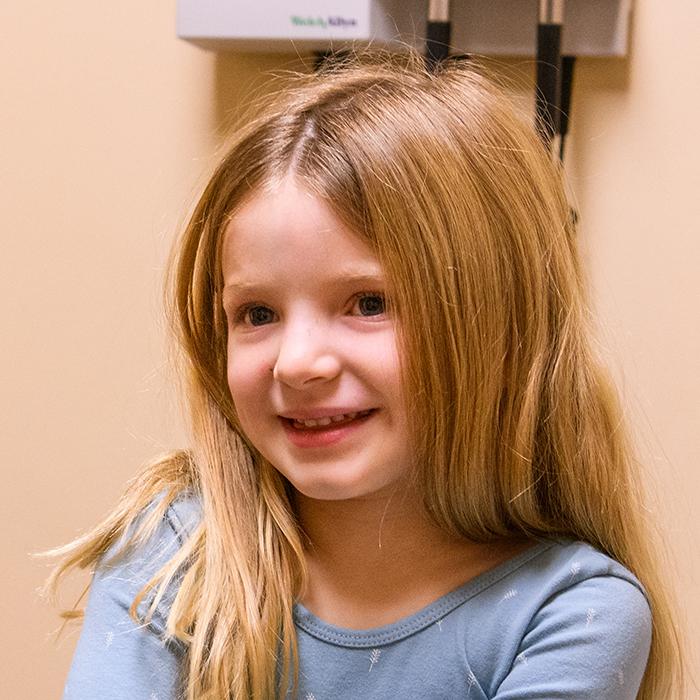Team Kaylee: A Roster Built for Success
As Amanda Davis sat through another ultrasound with globs of goo on her pregnant belly, she zeroed in on the doctor's face, looking for even the slightest hint of her daughter Kaylee's condition. Peter Dyke, MD, a pediatric cardiologist at MU Health Care, was there to get images of the baby's heart to evaluate the hole they discovered weeks before.
Kaylee wasn't making it easy. Through the kicks and twirls, Dyke was having a hard time getting the angles he needed. But rather than get impatient or frustrated, Dyke smiled. Which made Davis smile too.
"He was seeing her as a person before she was even here. I knew then we had the right doctor," said Davis, a resident of Montgomery City, Missouri.
Dyke was one of the first doctors to join "Team Kaylee," a roster that had begun growing shortly after Davis' 20-week ultrasound, when Kaylee's heart problem was first detected and Davis was referred to MU Health Care. At Children's Hospital, patients have access to experts in more than 25 pediatric specialties to handle the twists and turns of complex conditions — even before birth — and Kaylee was going to need many of them.
Davis already knew from previous appointments there was a good chance her daughter would be born with Down syndrome, but the news about her heart problem put any other concerns on hold.
"At that point, nothing else mattered," Davis said. "I just wanted her to live."
Building Team Kaylee
After Dyke finally got a good look at Kaylee's heart on the ultrasound, he told Davis her daughter's chances of survival were good but that she would need heart surgery shortly after she was born. Doctors carefully monitored Kaylee's growing heart, but at 33 weeks, Davis learned of a new complication.
 |
See how we help kids be kids. |
|---|
"I thought we had skated past another appointment, but then the doctors came back in," Davis said. "One of the specialists had caught something on the ultrasound showing Kaylee was anemic."
The doctors prepared for a fetal blood transfusion, where Kaylee would receive blood delivered through the umbilical cord.
"Anytime a baby is anemic in utero, they're at risk of heart failure." Dyke explained. "We were already dealing with a delicate situation with Kaylee and needed a transfusion to make sure we were getting her heart all the help it needed."
But before doctors could perform the transfusion, Davis' placenta ruptured, sending her into an emergency C-section. Kaylee was born at 33 weeks and spent the next 4½ months in the Children's Hospital NICU.
Blood tests revealed Kaylee had transient myeloproliferative, a bone marrow disorder that leads to an increased risk of developing leukemia before the age of 3. Barbara Gruner, MD, a pediatric hematologist, was added to the Team Kaylee roster, which had already grown to include a pediatric ophthalmologist, pulmonologist and gastrointestinal doctor.
"I learned there was a doctor for every part of your body," Davis said. "I never knew that before, and I just remember thinking, 'Wow' every time a new doctor walked in."
Once Kaylee grew big enough for heart surgery, she was transferred to St. Louis for a complete repair of the atrioventricular canal — the tissue that separates the upper and lower chambers of the heart. After a month of recovery in the NICU, Kaylee was finally ready to go home.
Going Home
Because of all the time she spent in the NICU, Kaylee had missed her window of opportunity to learn how to suck from a bottle. So at 5-months-old, she was sent home with a G-button, or gastrostomy tube button, that allows food to go directly into the stomach. The plan was to work closely with the feeding and swallowing specialists at Children's Hospital to gradually teach her to eat and drink on her own.
However, during a routine swallow study, they found Kaylee was experiencing silent aspiration — a condition in which food and liquids get into the lungs but cause no obvious outward symptoms. Kaylee was immediately referred to Children's Hospital's Aerodigestive Program.
"Whenever a child has aspiration, it's extremely important to get them seen and cared for right away." said Eliav Gov Ari, MD, pediatric ear, nose and throat specialist and head of the Aerodigestive Program. "Aspiration can be caused by a variety of issues, each with their own risks, and lead to long-term damage in the lungs and esophagus, as well as issues with weight gain and nutrition. That's why our program includes so many specialists — we're all looking at how that one overlying issue is affecting the entire body and coming up with the best solution."
 |
Learn more about our new children's hospital |
|---|
Gov Ari found a small gap, called a laryngeal cleft, just above Kaylee's voice box that was allowing liquid to slip through to her lungs. Severe clefts require extensive surgery to be repaired, but since Kaylee's was small enough, Gov Ari took a more conservative approach.
"Dr. Gov Ari is not the type to dive right into surgery unless he has to, and I really appreciate that about him," said Davis, who had already seen her daughter undergo open heart surgery and eye surgery for infantile glaucoma.
He started Kaylee on intensive drinking therapy, in which dietitians and swallow therapists work together to find a thickened liquid consistency that prevents anything from slipping past the gap. It can be a delicate balance to find a consistency that's thick enough to not slip through, but not too thick it makes a child feel too full.
The goal was twofold: give Kaylee's body time to heal the cleft on its own and allow her to drink enough fluids to reach her next big milestone — getting rid of her feeding tube.
Milestones and Blessings
Step-by-step milestones are a major focus of Team Kaylee, especially at the Children's Therapy Center where Kaylee has worked hard for years. From learning how to sit up to now using ankle braces to walk, Davis attributes many of Kaylee's achievements to the help of the therapy team.
"They not only help during therapy sessions, but also teach you what to do on your own," Davis said. "Without the extra therapy at home, Kaylee wouldn't be doing as well as she is."
Davis admits having so many appointments can be a bit overwhelming at first, but Team Kaylee has mastered the art of stacking appointments and coordinating.
"Everyone works extremely well together. If Dr. Gov Ari is going to put Kaylee under to place tubes in her ears, Dr. Dyke schedules his ECHO at the same time so she doesn't have to go under twice," Davis said. "We've even had our dentist come when she was put to sleep so she could get X-rays.
"It's a powerful thing when you have a team of providers working together to help your child. They see her as Kaylee and provide the best possible care for her. We're very blessed."
Kaylee's treatment is ongoing, but as Davis watches her walking, talking 6-year-old kindergartener navigate the world, she knows the future is bright — as bright as the faces of the people who meet her.
"Kaylee loves people and will just give a random person a hug," Davis said. "It's the neatest thing to see people's faces light up immediately after. I've definitely learned it's not as scary as you think having a kid with special needs. Once you get over the fear of the unknown, there is just so much joy and blessings."






